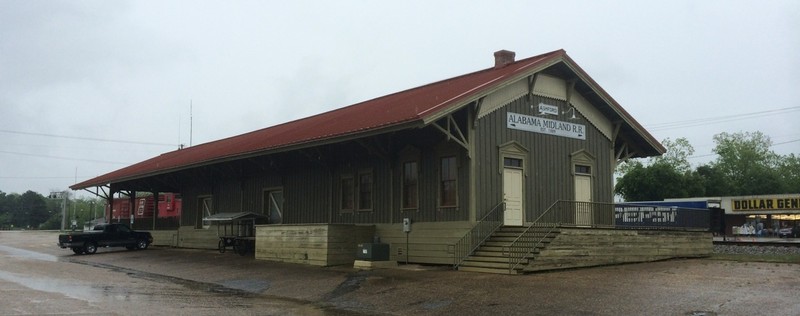Ashford Depot and Museum
Introduction
Text-to-speech Audio
Images
A photo of the depot from 2014

Backstory and Context
Text-to-speech Audio
When the town of Ashford incorporated in 1891, the townsfolk already had clear intent and desire to build a railway depot for the town. The original papers of incorporation state that the town would be located with the Alabama Midway Railroad Depot as the town center. In 1888 the Alabama Midland Railroad company and its Georgia counterpart had consolidated to form a complete rail line from Bainbridge, Georgia to Montgomery, Alabama. Eventually, this section of rail was completed in 1889.
In 1892 the Alabama Midland Railway Depot was built for the construction cost of $4,500. The depot is an example of late 19th century Victorian Railroad Architecture, featuring various Victorian cuts and design choices that anchors it in the period of its construction. Being from this period, this depot is one of the oldest remaining depots in Southeast Alabama with very few remaining examples in the vicinity. Since it was situated in the center of Ashford, it was a meeting point for locals to sell or trade their products and crops off of the back of their wagons or trucks. Locals would also use the depot to ship their goods to buyers elsewhere, making the depot a vital lifeline. At the time of its construction, Ashford was a small lumber and naval stores producing village, shipping out products like pitch, tar, and turpentine. In 1915 a fire swept through the town of Ashford, burning all other buildings to the ground, the depot was the only building to survive.
In the early 1970s, the railroad company closed down and the Ashford Gin Company used the building until 1982 when the company bankrupted. After the Ashford Gin Company Bankrupted the company gave the building to the City of Ashford. Despite the various changes of hands over the course of its history, the building remains overall mostly unchanged.
On September 12th, 1985, the efforts of the Estelle Manley Chapter of the United Daughters of the Confederacy were successful in adding the depot to the National Register of Historic Places. In 1989 a historical marker was added by the Historic Chattahoochee Commission and the Ashford Depot Committee. Later the building was renovated by the City of Ashford between September 2004 and November 2005.
Today the building serves as a museum for Ashford, focusing on exhibits about the “Golden Age” of railroads in southeast Alabama. As part of the museum, a restored caboose and cargo rail car are adjacent to the depot section of the museum.
Sources
Hilton, Mark. Ashford Depot, Historical Marker Database. September 7th 2020. Accessed November 30th 2020. https://www.hmdb.org/m.asp?m=73355&Result=1.
Bruner Jr., S. G. . Alabama Midland Railroad Depot and Museum, Encyclopedia of Alabama. September 8th 2011. Accessed November 30th 2020. http://www.encyclopediaofalabama.org/article/h-3015.
Bailey, Michael. Alabama Midland Railway Depot, National Register of Historic Places. September 12th 1985. Accessed November 30th 2020. https://npgallery.nps.gov/NRHP/AssetDetail?assetID=2be609f2-aff2-46df-a247-fdf8bf48ef14.
Photo taken by: Mark Hilton. Image sourced from HMDB.org: https://www.hmdb.org/PhotoFullSize.asp?PhotoID=271974
